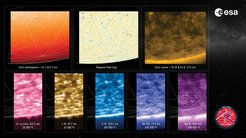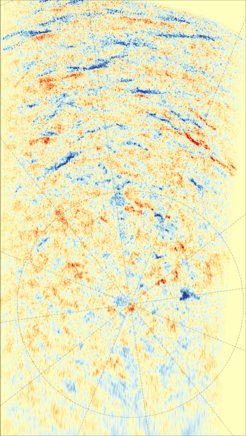First images of the Sun's south pole
Solar Orbiter is the first space probe to look at the Sun's poles – and finds the magnetic field there in a state of turmoil. The Sun's magnetic field is currently undergoing a flip.
During its latest flyby of the Sun at the end of March this year, the Solar Orbiter space probe had its first clear view of our star's poles. The first images and observational data from the south pole taken during this flyby were published today. The solar poles are largely unexplored; no space probe has ever seen them before. Solar Orbiter's trajectory has recently been tilted 17 degrees relative to the Sun's equator, allowing measurements from this unique perspective for the first time. The timing of the flyby in March this year was ideal. The Sun is currently passing through the maximum of its approximately eleven-year activity cycle. During this period, the polarity of its magnetic field reverses. As the new observations impressively show, the magnetic field at the poles is in a state of turmoil during this phase.

These data were recorded by three of Solar Orbiter’s scientific instruments: the Polarimetric and Helioseismic Imager (PHI), the Extreme Ultraviolet Imager (EUI), and the Spectral Imaging of the Coronal Environment (SPICE) instrument.
PHI captures the visible light sent out by iron particles (617.3 nanometre wavelength, top left), revealing the Sun's surface (photosphere). PHI also maps the Sun’s surface magnetic field along the spacecraft's line of sight (top centre). In this map, blue indicates positive magnetic field, pointing towards the spacecraft, and red indicates negative magnetic field.
EUI images the Sun in ultraviolet light (17.4 nanometre wavelength, top right), revealing the million-degree charged gas in the Sun’s outer atmosphere, the corona.
The SPICE instrument (various wavelengths, bottom row) captures light coming from different layers above the Sun's surface, from the chromosphere right above the Sun's surface all the way to the Sun's corona.
Virtually all space probes that explore the Sun from space view our star from the ecliptic. This is the plane in which the planets orbit the Sun. Although this plane is slightly tilted relative to the Sun's equator, the angle of about seven degrees is not enough to catch a clear view of our star's poles. Solar telescopes on Earth naturally have the same limited perspective. Only Ulysses, a joint mission of the European and American space agencies ESA and NASA, flew over the Sun's poles several times between 1990 and 2009, albeit from a much greater distance than Solar Orbiter and without imaging instruments on board. The Sun's poles are of particular interest to researchers. The processes taking place there are likely to play a decisive role in the Sun's activity cycle.
The Sun's “internal clock”

The Sun is subject to an approximately eleven-year cycle. Roughly every eleven years, it reaches its activity peak. During this period, as in recent months and currently, it is particularly active. Violent bursts of radiation and particles often occur during this time. In recent months, some of these have triggered impressive auroras that were visible even in central and southern Europe. In addition, many dark sunspots, areas with particularly high magnetic field strength, appear on the Sun’s visible surface during this period. Between peaks of activity, the Sun comes to rest: eruptions occur seldomly and sunspots often remain completely absent for several months at a time. The basis of the solar cycle, our star’s “internal clock”, is not yet understood. Researchers suspect that the crucial puzzle piece missing for a deeper understanding lies at the poles. Finding this piece of the puzzle is one of the most important mission objectives of Solar Orbiter.
To this end, the probe used the momentum from its flyby of Venus on February 18 this year to leave the ecliptic. About a month later, on March 22, the probe looked at the Sun from an angle of 17 degrees for the first time. "We didn't know what exactly to expect from these first observations. The Sun’s poles are literally terra incognita," says Sami Solanki, director at the Max Planck Institute for Solar System Research (MPS) in Göttingen (Germany) and Principal Investigator of Solar Orbiter's Polarimetric and Helioseismic Imager (PHI).
A look at the surface, magnetic field, and corona
The images published today were taken on March 16 and 17 of this year, a few days before reaching the highest deflection from the ecliptic, from an angle of 15 degrees. In addition to PHI, the Extreme Ultraviolet Imager (EUI) and the instrument Spectral Imaging of the Coronal Environment (SPICE) instruments also captured unique images. The MPS contributed sub-instruments and hardware components to EUI and SPICE; the PHI was developed under the leadership of the MPS. While PHI captures the visible light of the Sun and thus images the Sun's surface and its magnetic field there, EUI and SPICE look at the higher layers of the Sun up to the hot solar corona. The images from these instruments can help understand how the Sun manages to fling the particles of the solar wind into space.
PHI's pole-to-pole view of the Sun's magnetic field
The images from PHI show the magnetic field at the solar south pole in a state of turmoil. In general, the Sun's magnetic field is much more complex than that of Earth. Many small, variable, and highly complex magnetic structures, which occur in connection with sunspots or at the poles, generate the Sun's large-scale, global magnetic field. During much of the solar cycle it resembles that of a bar magnet, with the poles of the Sun roughly corresponding to the magnetic poles. The global magnetic field reverses its polarity during the Sun's maximum activity, approximately every eleven years. The small magnetic structures at the poles are likely to play an important role in this process.
Researchers expect the magnetic field at the poles to change significantly during the solar cycle. While one magnetic polarity is likely to predominate there during the minimum activity phase, the magnetic field should be significantly more complex during the maximum. This is confirmed by the latest observations. At the south pole, observational data from PHI reveal an intricate jumble of small areas with different polarities.
Solar Orbiter zooms into the Sun’s south pole
“Solar Orbiter has taken up its new observation position at exactly the right time,” says MPS scientist and PHI operations scientist Johann Hirzberger. “PHI was able to map the magnetic field at the South Pole at a key moment,” he adds. The team is now eager to follow the restructuring of the polar magnetic field over the coming months and years. Current forecasts indicate that solar activity will decrease slightly from its current high level. By the end of 2026, Solar Orbiter will be able to observe the north and south poles of the Sun three more times from an angle of 17 degrees. Another flyby of Venus on December 24, 2026, will further tilt the probe's orbit to an angle of 23 degrees. This will provide an even better view of the poles.
About the mission
The Solar Orbiter space probe, a joint project of ESA and NASA, was launched into space in February 2020. Since then, the probe has been traveling in elongated ellipses around the Sun, reaching its perihelion about twice a year. At this point, Solar Orbiter is only about 42 million kilometers from our star. That is slightly less than one-third of the distance between Earth and the Sun. In recent years, this position has yielded unique observations and high-resolution images of the solar corona, among other things. In about two years, the probe's trajectory will be tilted even more, eventually reaching an angle of 33 degrees by the end of the mission.
The MPS is involved in four of the ten scientific instruments on Solar Orbiter. The institute contributed sub-instruments and hardware to the EUI, SPICE, and Metis instruments. PHI was developed and built under the leadership of the MPS.













